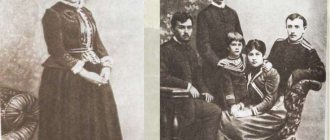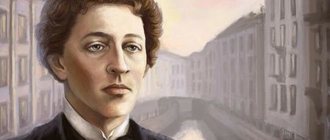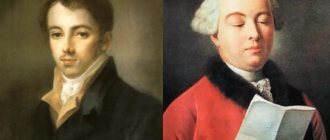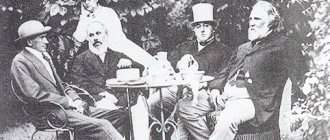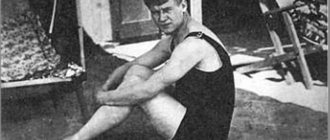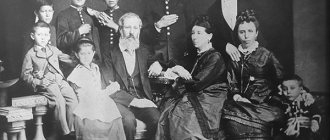Childhood and youth
August 23, 1880, Slobodskaya. Here, a boy was born to the Pole Stepan Evseevich Grinevsky and Anna Stepanovna Lepkova (mother’s maiden name), who was given the name Alexander . Alexander had another brother and two sisters born after him.
Parents: Stepan Evseevich and Anna Stepanovna
Despite the fact that the eldest son was left to his own devices most of the time, he learned to read and write early (he was 6 years old) and began to read voraciously. Most of all, he loved adventure novels about sailors, since from childhood he wanted to be a sailor .
In 1889, the boy began studying in a preparatory class at a local school, where he received the nickname “Green,” which later became his creative pseudonym. He studied poorly, and his behavior left much to be desired. Therefore, Alexander was soon expelled from the school. But under the patronage of his father, he was transferred to another, less prestigious one. In 1895, the young man’s mother dies of tuberculosis. 4 months after her death, her father remarries. However, Alexander’s relationship with his stepmother did not work out, and he was forced to live alone.
In young age
This is interesting: Facts about the axolotl
The beginning of a creative journey
In 1906–1908 A turning point came in A. Green's life. In the summer of 1906, two stories came from his pen, which were published in the fall of the same year. The genre of early stories was defined as propaganda brochure. They were dedicated to the soldiers of the tsarist army, who after the revolution of 1905 often staged bloody punitive raids.
The aspiring writer received a fee, but the entire circulation was destroyed.
At the beginning of 1908, Greene published his first collection. Most of the collection was dedicated to the Social Revolutionaries.
In 1910, the writer published a second collection. Most of it consisted of stories written in the genre of realism. Having shown himself as a budding writer, he met M. Kuzmin, V. Bryusov, L. Andreev, A. Tolstoy. He became closest friends with A.I. Kuprin.
The writer was mainly published in the small press. His stories were published in Birzhevye Vedomosti, Niva, and Rodina. He occasionally published in Modern World and Russian Thought.
In 1914, Alexander Green began collaborating with the New Satyricon magazine. This magazine published his collection An Incident on Dog Street.
After the outbreak of the First World War, another turning point emerged in the writer’s work. His stories began to be anti-war in nature.
short biography
- Odessa life . 1896 After graduating from college, Alexander leaves for Odessa. The young man had only 25 rubles with him, which his father provided him with. However, such a negligible amount could not help him get a normal job. Therefore, for some time the future writer becomes a vagabond. Then, with the help of his father’s friend, he gets a job as a sailor on the ship “Plato”. But I had to say goodbye to the dream of a sailor, since the reality turned out to be very harsh and unfair.
- Soldier's service . 1902 Alexander becomes a soldier in the royal army in order to at least be well-fed and have a roof over his head. His place of service was Orovai Reserve Infantry Battalion No. 213, which was stationed in Penza. However, the lack of rights and harsh attitude towards the soldiers on the part of the officers led to the fact that the young man could not bear such an attitude towards himself and ran away. It was then that Greene's revolutionary spirit appeared.
- Arrest . 1903, Sevastopol. Alexander Green is arrested for activities directed against the existing system and sent to a maximum security prison. The basis is escape.
- Court . February 1905, Sevastopol. Alexander Stepanovich was sentenced by a naval court to 10 years in Siberian exile. Green received such a sentence thanks to the defense of the famous lawyer Alexander Sergeevich Zarudny, although the prosecutor wanted him to be given 20 years of hard labor.
- Liberation . October 1905. Green was released due to a general amnesty.
- Re-arrest . January 1906, St. Petersburg. Green was arrested again and then exiled for 4 years to the city of Turinsk, from which he fled 3 days later to his father in his native Vyatka so that he could help him get another passport.
- Debut story . Summer 1906. Alexander Green’s debut work was the story “The Merit of Private Panteleev,” in which he wrote about gross violations in the tsarist army. The fate of this story was very deplorable, since the police destroyed the entire printed edition.
- Publication of the first collection . 1908 Green manages to publish the first collection of his stories, “The Invisible Cap,” dedicated to revolutionaries.
- Release of the second collection . The year 1910 was marked by the release of the second collection of stories by Alexander Stepanovich, in which his future writing genre was already clearly visible.
- Magazine employee . 1914 Green gets a job at the New Satyricon magazine, which is quite popular among the readership. Moreover, Green manages to publish a collection of stories he wrote, “An Incident on Dog Street,” in an appendix to the magazine.
- The flourishing of writing talent . 1923 Green receives a fee for the published novel “The Shining World,” which he spends on a trip to Crimea. After returning from their trip, Nina and Alexander move to another apartment consisting of four rooms. In the same year, Green published his famous enchanting work “Scarlet Sails”.
- Moving to the south . Summer 1924. Green, along with his wife and her mother, are moving to Feodosia for permanent residence. Here he writes the novel “The Golden Chain”.
- The main masterpiece . Autumn 1926. The writer’s main masterpiece was the novel “Running on the Waves,” which he wrote for 18 months.
- The writer's latest novels . In 1929, the writer's last two novels were published. These are: “The Road to Nowhere”; "Jesse and Morgiana."
- Death . During his turbulent life, Alexander Stepanovich often had to go hungry. Over time, this led to stomach cancer, which became the cause of the writer’s death. The writer left this world on July 7, 1932.
Alexander Green shortly before his death
Finding myself
Arriving in Odessa, the teenager could not find a job and experienced serious financial difficulties. His father’s friend finally got him a job as a sailor on a ship sailing from Odessa to Batumi. Alexander did not like working on the ship, and he quickly abandoned it. In 1897, he decided to return to his homeland, where he lived for a year, and then set off on a new journey - to Baku.
On Azerbaijani soil, he worked on the railway tracks, was a laborer and a fisherman. He came to his father for the summer, and then went on his journey again. For some time he lived in the Urals, cut down forests, was a miner, and served in the theater. And each time he was forced to return to his hated native land.
A. Green with his friend E. Vensky
Childhood and adolescence
Alexander Stepanovich Green was born on August 11 (23), 1880, in the city of Slobodskaya Vyatka province. His father, S. Grinevsky, a Polish nobleman, was a participant in the January Uprising, for which he was exiled to the Tomsk province.
The future writer learned to read at the age of six. Since childhood, he was “sick” of the sea and dreamed of becoming a sailor. Several times little Sasha attempted to run away from home.
The home education of the future writer was not consistent. Unreasonable caresses were abruptly replaced by severe punishments. Sometimes the child was left to his own devices.
In 1889, Sasha entered the preparatory class of the local real school. There the nickname “Green” was “born”, which later became his literary pseudonym.
Biography of Gogol
Alexander studied poorly and, according to the memoirs of his contemporaries, was an “inveterate hooligan.”
When the young man was fifteen years old, his mother died of tuberculosis. Having married a second time, the father became estranged from his son, and young Green was forced to start an independent life.
Personal life
Despite his complex character, Alexander Green had many women. But for the first time he truly fell in love with the hereditary revolutionary Ekaterina Alexandrovna Bibergal . They met in Sevastopol in 1903. The young people were brought together by the dream of revolution. However, their relationship did not last long and almost ended the young woman’s life. Greene shot her for refusing to marry him. Fortunately, Catherine remained alive, but she never saw Alexander again.
Ekaterina Bibergal
Green's first official marriage was with a pretty girl, Vera Pavlovna Abramova, who sympathized with the revolutionaries. Their marriage lasted 7 years and then broke up in 1913, but they managed to maintain good relations.
Vera Abramova
Green married for the second time completely by accident in 1918. His wife was Maria Vladislavovna Dolidze . This marriage did not last long and broke up due to the fault, as many researchers of Greene’s work believe, of the wife, who could not withstand the complex character of her husband.
The writer's third wife was Nina Nikolaevna Mironova , whom he married in the spring of 1921. She was 14 years younger than him. Green lived with Nina Nikolaevna for 11 years. And only death broke off this rather strong union.
Alexander Green with his wife Nina
Recognition of creativity
Greene's works were actively published after his death until 1944. “Scarlet Sails” was especially popular: it was read on the radio, and the ballet of the same name was shown at the Bolshoi Theater. During the struggle against cosmopolitanism, Greene, like many writers, was banned. In 1956, his works returned to literature. The writer's wife opens the Greene Museum in their home. In 1970, a museum was opened in Feodosia, in 1980 - in Kirov, in 2010 - in Slobodskoye.
Green's work is considered special; the writer was not influenced by his predecessors, had no successors, and the genre of his works defies classification. Sometimes they tried to compare him with foreign authors, but the comparison turned out to be too superficial. Some Russian libraries and streets in several cities are named after Green. His works have been filmed several times.
Interesting Facts
- In his youth, Green was a desperate rebel. His relations with the royal authorities were very difficult. Since the end of 1916, he was hiding from persecution in Finland. He returned to Russia only after the February Revolution.
- Having become a famous writer, Greene got rid of poverty. But the money did not stay in his hands. The writer was a fan of card games and night debauchery.
- In May 1932, a transfer was received from the Writers' Union addressed to the writer's wife, N. Green. The strange thing was that it was sent to the name of the “widow,” although Alexander Stepanovich was still alive. According to some reports, this happened against the backdrop of the writer’s mischief. A few days earlier, he sent a telegram with the words “Green is dead, send two hundred funerals.”
- The writer's wife, Nina, was his muse. It was she who became the prototype of Assol from “Scarlet Sails”.
- A minor planet was named in honor of the writer. In Riga there is Alexander Green Street. But it was named in honor of its full namesake, Alexander Stepanovich, who was also a writer.
This is interesting: People who snore have less gray matter in their brains
End of life
Photo 1929
Starting in 1930, Greene was prohibited from reprinting; he was allowed to print one book per year. The Writers' Union did not help, no pension was granted. Life ended in the summer of 1932.
Wikipedia listed the cause of death as stomach cancer; the lungs were also affected. He was buried in Old Crimea. Before his death, Alexander Stepanovich confessed and received the Holy Mysteries of Christ.
Until his death, Grinevsky kept portraits of his father and first wife. He dedicated his best work to his wife Nina - the story “Scarlet Sails”.
The life and work of Alexander Green present the greatest contrast. At the beginning of his life, the writer visited the bottom of society, saw the abomination of human vices.
The creative path was not difficult - a rich imagination helped in writing books. The author had many ideas, improved from work to work and did not run out of steam. The refusal to publish deprived the writer of the strength to live. The novel “Touchy” remained unfinished, which could have become the author’s best work.
Bibliography
- 1906 – “To Italy”
- 1907 – “Oranges”
- 1907 – “Beloved”
- 1908 – “The Tramp”
- 1908 – “Two Men”
- 1909 – “Airship”
- 1909 – “Maniac”
- 1909 – “An Incident in Dog Street”
- 1910 – “In the Forest”
- 1910 – “Box of Soap”
- 1911 – “Moonlight Read”
- 1912 – “The Winter's Tale”
- 1914 – “Without an audience”
- 1915 – “The Lunatic Aviator”
- 1916 – “The Mystery of House 41”
- 1917 – “Bourgeois Spirit”
- 1918 – “Bulls in Tomatoes”
- 1922 – “White Fire”
- 1923 – “Scarlet Sails”
- 1924 – “The Cheerful Fellow Traveler”
- 1925 – “Six Matches”
- 1927 – “The Legend of Ferguson”
- 1928 – “Running on the Waves”
- 1933 – “Velvet Curtain”
- 1960 – “We sat on the shore”
- 1961 – “Stone Pillar Ranch”
